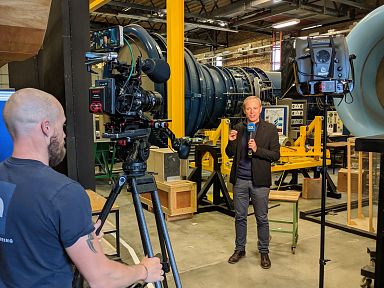Aircraft engineeers face enormous challenges developing new aviation technologies which correspond to all the demands society makes, from cutting greenhouse gas emissions to cutting ticket prices for passengers.
Aircraft engineers face enormous challenges developing new aviation technologies which correspond to all the demands society makes, from reducing greenhouse gas emissions to cutting ticket prices for passengers.
Introducing any significant design change into commercial aircraft requires many years of testing, not least to meet stringent safety standards.
Euronews heard from Dr Cesare Hall at the University of Cambridge in the UK, an expert in turbomachinery aerodynamics, and one of the team working on the Centreline project, the focus of our Futuris report.
He showed us a futuristic lifting wing design for a low-noise and high efficiency blended-wing aircraft, and a windtunnel test model for the Centreline project's wake-filling aircraft design, which uses a third electrically-driven fan at the rear of the aircraft to exploit the energy of the layers of air close to the fuselage to create thrust.
"The idea is to have very low noise engines, but also these engines ingest the airflow over the top surface, and turn that airflow into thrust, and reduce the fuel burn of the aircraft. So it's very low noise and highly efficient. But the huge challenge is that there are so many new technologies in this design that it's very many decades into the future that we'll see this flying, and it would be a huge amount of work to develop an aircraft like this," Dr Hall said.
"The aircraft design we're looking at here is still a conventional 'tube and wing' kind of design of aircraft, where you have the large engines under the wings, providing most of the thrust. But also, we're changing the rear of the aircraft. At the back of the fuselage we have an additional propulsor, which is driven electrically from the main engines. The purpose of this propulsor is to ingest the airflow over the fuselage. This airflow would normally form a wake behind the aircraft, and generate a lot of drag, and we want to take in that airflow, turn it into thrust, and make the propulsion much more efficient."












